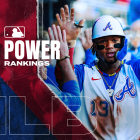
More MLB: Scoreboard | Standings | Probable Pitchers | Sortable Stats | Odds
Remember when Braves slugger Justin Upton was master of all that he surveyed?
Not so long ago -- as recently as May 1 -- Upton was pounding the ball to the extremes of .298/.400/.722 and was on pace for more than 50 homers. These days, Upton's slash line is a far more mortal .241/.351/.455. That's still productive (118 OPS+), but baked into those overall numbers are an otherworldly April and an abysmal May and June. The question is thus raised: What's happened to Upton?
To begin our probe of this issue, let's take a look at some of Upton's monthly splits for the season:
| Justin Upton's monthly splits, 2013 | |||||
| Month | AVG/OBP/SLG | BABIP | BB/K ratio | GB/FB ratio | HR/FB% |
| April | .298/.402/.734 | .302 | 0.53 | 0.71 | 38.7% |
| May | .211/.327/.326 | .290 | 0.53 | 1.45 | 9.1% |
| June | .208/.319/.273 | .273 | 0.59 | 1.35 | 5.0% |
| Data courtesy of FanGraphs | |||||
First, some quick notes on the possibly unfamiliar categories that you're seeing above ... BABIP is "batting average on balls in play," which measures what percentage of fair balls that aren't home runs go for hits. While hitters have a good bit of control over their BABIPs, there's still some luck involved. BB/K ratio is simply Upton's walks divided by his strikeouts. The higher the figure, the better for a hitter. It's a simple measure of plate discipline and command of the strike zone. GB/FB ratio is the hitter's ground balls divided by fly balls. And finally HR/FB% is the percentage of fly balls that go for homers. Again, a hitter has some control over this statistic, but wide swings can be the result of luck, bad or good.
Insofar as Upton in 2013 is concerned, the BABIP isn't too widely divergent, and the BB/K ratio is even more compressed. Mostly, it's a matter of fly balls and what Upton has been doing with them since April.
As you can see, Upton of late is hitting a much larger percentage of balls on the ground -- twice as much from April to May -- and the balls that he is lofting aren't leaving the park all that often. To be sure, Upton's April HR/FB of 38.7 percent was never close to sustainable (for instance, Barry Bonds in 2004, when he tallied 45 homers in just 373 at-bats, had a HR/FB of "just" 29.0 percent), but his May and June marks are well below his career HR/FB of 14.3 percent. On that front, Upton's probably having a bit of bad luck lately, just as he had a great deal of good luck in the first month of the season.
A perhaps greater concern is Upton's inconsistency when it comes to hitting the ball in the air. The major-leaguer average ground-ball percentage is typically around 44, and Upton is at his best when he's well below that mark, as he was in 2011, when he finished fourth in the NL MVP balloting. His career numbers suggest that he'll once again start driving the ball, but those same career numbers suggest it's anyone's guess as to when that will happen.
Another factor -- and one perhaps underlying what we've just discussed -- is that Upton has lately been struggling badly against same-side pitching. In April, Upton batted a robust .313/.382/.716 against right-handers. Since then, though, he's batted just .198/.291/.252 against righties while maintaining a quality .244/.415/.463 slash line against lefties. To boot, Upton faced a higher percentage of right-handers from May through June than he did in April. That didn't help matters. For what it's worth, Upton for his career owns a career line of .272/.343/.458 versus right-handers. While April's success in platoon-disadvantaged situations was clearly fluke, so, too, have been the struggles since.
The upshot is that Upton will probably soon find a middle ground. He's not going to hit such a high rate of fly balls out of the park and abuse right-handers like he did in April, at least over a large sample. At the same time, he's not going to put half his batted balls on the ground and slug under .300 against right-handers, as he's done in May and June. Getting past his recent hand injury will also aid his cause. Soon enough, Upton's going to settle into what he has long been: a plus hitter with lots of power and some platoon issues.
On that point, the Steamer projection system available at FanGraphs tabs Upton for a batting line of .276/.364/.492 with 15 homers over the balance of the 2013 season. Given what we know about his tendencies and body of work, that strikes me as a very reasonable estimation.
Braves fans should know that, in terms of the recent past, Upton's better than this, but he's not as good as his fiery start to 2013.





















